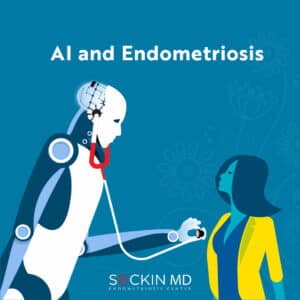AI and Endometriosis

Big data, artificial intelligence (AI), and machine learning (ML) are buzzwords that have found applications in most spheres of life. AI brings the promise of more efficient work and a synthesis of diverse data points to offer new insights. These developments are now also making their way to endometriosis diagnosis and treatment. Here is the first of our series on AI and how it can be relevant for endometriosis.
What is AI?
AI helps computers perform functions normally associated with human intelligence. These include visualization, language translation and transcription, and data analysis.
Currently, limited memory AI is trained on data using a so-called neural network. Researchers model these neural networks based on neuronal interconnections within the human brain. These neural networks can help perform complex computations such as speech recognition, image recognition and captioning, prediction making, and generating information and images from natural language prompts.
AI is already being used in medicine to help assess the risk of disease onset, assist in palliative care, and enhance knowledge of disease etiology.
Scientists are now also assessing how it may be useful in endometriosis from diagnosis to treatment.
AI for the diagnosis of endometriosis
A 2021 study that assessed the utility of AI in the detection of rectosigmoid deep endometriosis developed a Neural Net algorithm that showed good accuracy and sensitivity. The researchers trained the model using 222 datasets containing information such as age and the presence of adenomyosis, endometriomas, adhesions, kissing ovaries, and sliding signs.
A 2022 literature review of 36 studies indicated promising results for the use of AI in the diagnosis of endometriosis. The selected studies used various parameters. These included biomarkers, clinical and genetic variables, metabolite signatures, imaging test findigns, and lesion characteristics.
Currently, a team of researchers in the United Arab Emirates is developing an AI model using the popular GPT-3 large language model. The model can interact with patients and perform an early prediction of endometriosis based on their responses to queries. According to the researchers, there is more than 95% congruence between the AI’s inference and that of a gynecologist.
Two institutes of the University of Adelaide — the Robinson Research Institute and the Australian Institute for Machine Learning — are also developing a model called IMAGENDO. This model can read scans and recognize patterns that are indicative of endometriosis. The algorithm combines data from transvaginal ultrasound and magnetic resonance imaging (MRI) findings to provide a real-time assessment of image quality and inferred diagnosis. The IMAGENDO study is currently recruiting women aged 18 to 45 years with planned pelvic surgery.
AI for decision-making regarding endometriosis
A study called DEFEND aims to harness a database of ultrasound and MRI images to create and train an AI model to not only help better diagnose endometriosis but also make decisions about its management. The study is a collaboration between The King’s Fertility Clinic in Denmark, Perspectum, and GE Healthcare. It is currently recruiting participants and aims to enroll 100 patients with endometriosis.
The FEMaLe project aims to develop augmented reality experiences using AI and big data to provide better organ visibility and guide surgeons with precise maneuvers toward endometriosis lesions during surgery.
Finally, AI can help predict the success of assisted reproductive techniques (ART) such as in vitro fertilization. Therefore, it can help decision-making about whether or not the patients should undergo IVF.
What are some current limitations of using AI?
The use of AI in endometriosis is still a nascent development and is associated with ethical and safety concerns. There are also challenges in terms of training the models. Bias and interpretation of data should, therefore, be balanced to increase the applicability of AI in medicine.
Factors such as disease staging, sample size, and training multiple models are necessary. More sampling, external validation, defining parameters, and subjecting these to extensive clinical trials are important. Only then can AI become truly viable in routine medical practice.
Please share your thoughts about the use of AI in endometriosis. Please leave a comment on our post on Facebook or Instagram.
Get a Second Opinion
Our endometriosis specialists are dedicated to providing patients with expert care. Whether you have been diagnosed or are looking to find a doctor, they are ready to help.Our office is located on 872 Fifth Avenue New York, NY 10065.
You may call us at (646) 960-3080 or have your case reviewed by clicking here.